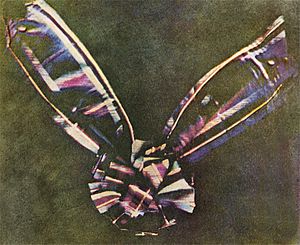Thomas Sutton (photographer) facts for kids
Quick facts for kids
Thomas Sutton
|
|
|---|---|
| Born | c. 1819 |
| Died | 19 March 1875 (aged 55–56) |
| Occupation |
|
Thomas Sutton (born around 1819 – died March 19, 1875, in Kensington) was an English photographer. He was also a writer and an inventor.
Meet Thomas Sutton: A Photography Pioneer
Thomas Sutton went to school in Newington Butts. He studied architecture for four years. Later, he went to Caius College, Cambridge. He finished his studies in 1846. He was a very good student, ranking 29th in math.
In 1847, Sutton opened a photography studio. It was in Jersey, an island near France. Prince Albert supported his work.
In 1855, Sutton started a photography company. His business partner was Louis Désiré Blanquart-Evrard. They made prints from early photo negatives called calotypes. The next year, they started a magazine called Photographic Notes. Sutton was the editor for eleven years. He wrote many books about photography. One famous book was the Dictionary of Photography in 1858.
Sutton's Cool Inventions
Thomas Sutton invented some amazing cameras. In 1859, he created the first panoramic camera. This camera had a special wide-angle lens. The lens was a glass ball filled with water. It could capture a very wide picture, like a 120-degree view.
In 1861, Sutton also invented the first single lens reflex (SLR) camera. This type of camera lets you see exactly what the lens sees.
The First Permanent Color Photo
Thomas Sutton helped make history in 1861. He was the photographer for James Clerk Maxwell. Maxwell was a famous scientist. They worked together to show how colour photography could work.
Maxwell had an idea about how to make color photos. Sutton helped him test it. Sutton took three black-and-white pictures of a colorful ribbon. Each picture used a different color filter:
- One photo used a blue filter.
- Another used a green filter.
- The last one used a red filter.
Then, they used three projectors. Each projector had a similar color filter. They shined the three photos onto a screen at the same time. The colors mixed together. This created a full-color image of the ribbon!
At the time, photographic materials were not perfect. They were mostly sensitive to blue light. They were not very good at seeing green or red. So, the result was not perfect, but it was a huge step.
Forty years later, new materials made this method work much better. This three-color method is still used today. It is how most color cameras and screens work.
Sutton's ribbon picture is often called the first color photograph. Other people had made color photos before. But their colors faded quickly in light. Sutton's photos stored the color information in black-and-white images. This meant they lasted a very long time. Because of this, his set of photos is known as the first permanent color photograph.
Sutton also worked on making dry photographic plates. These plates made photography easier.


